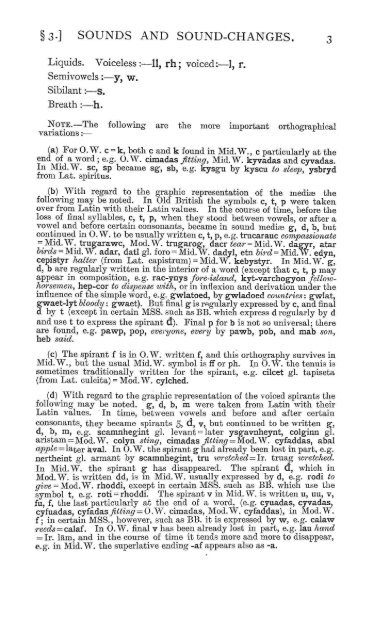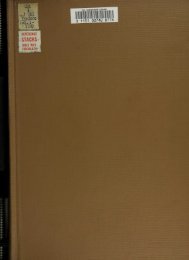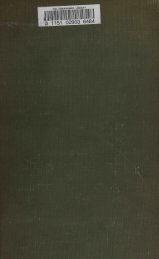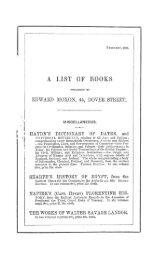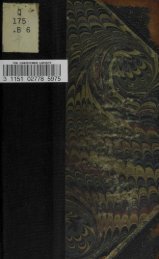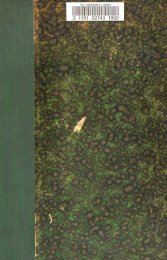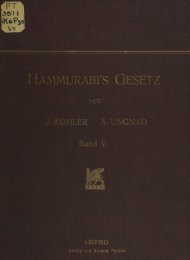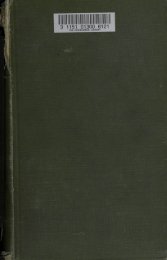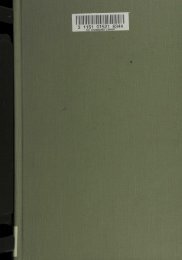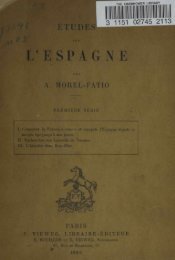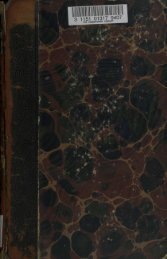T£ I'^'^l - JScholarship - Johns Hopkins University
T£ I'^'^l - JScholarship - Johns Hopkins University
T£ I'^'^l - JScholarship - Johns Hopkins University
Create successful ePaper yourself
Turn your PDF publications into a flip-book with our unique Google optimized e-Paper software.
§3-] SOUNDS AND SOUND-CHANGES. 3<br />
Liquids. Voiceless :—-11, rh; voiced:—1, r.<br />
Semivowels :—y, w.<br />
Sibilant:—s.<br />
Breath:—h.<br />
NOTE.—The following are the more important orthographical<br />
variations:—<br />
(a) For O.W. c = k, both c and k found in Mid.W., c particularly at the<br />
end of a word ; e.g. O.W. cimadas fitting, Mid.W. kyvadas and cyvadas.<br />
In Mid.W. sc, sp became sg, sb, e.g. kysgu by kyscu to sleep, ysbryd<br />
from Lat. spiritus.<br />
(b) With regard to the graphic representation of the medite the<br />
following may be noted. In Old British the symbols c, t, p were taken<br />
over from Latin with their Latin values. In the course of time, before the<br />
loss of final syllables, c, t, p, when they stood between vowels, or after a<br />
vowel and before certain consonants, became in sound mediae g, d, b, but<br />
continued in O. W. to be usually written c, t, p, e.g. trucarauc compassionate<br />
= Mid.W. trugaravyc, Mod.W. trug'arog-, dacr iear = Mid.W. dagyr, atar<br />
birds = M\ii.W. adar, datl gl. foro = Mid.W. dadyl, etn 6«V(^ = Mid.W. edyn,<br />
cepistyr halter (from Lat. capistrum) = Mid.W. kebystyr. In Mid.W. g,<br />
d, b areregularly written in the interior of a word (except tliat c, t, p may<br />
appear in composition, e.g. rac-ynys fore-island, kyt-varchogyon fellowhorsemen,<br />
hep-cor to dispense loith, or in inflexion and derivation under the<br />
influence of the simple word, e.g. gwlatoed, by gvsrladoed countries: gwlat,<br />
gwaet-lyt bloody: gwaet). But final g is regularly expressed by c, and final<br />
d by t (except in certain MSS. such as BB. which express d regularly by d<br />
and use t to express the spirant d). Final p for b is not so universal; there<br />
are found, e.g. pawp, pop, everyone, every by pawb, pob, and mab son,<br />
heb said.<br />
(c) The spirant f is in O.W. written f, and this orthography survives in<br />
Mid.W., but the usual Mid.W. symbol is ff or ph. In O.W. 'the tenuis is<br />
sometimes traditionally written for the spirant, e.g. cilcet gl. tapiseta<br />
(from Lat. culoita) = Mod.W. cylched.<br />
(d) With regard to the graphic representation of the voiced spirants the<br />
following may he noted, g, d, b, m were taken from Latin with their<br />
Latin values. In time, between vowels and before and after certain<br />
consonants, they became spirants 5, d, v, but continued to be written g,<br />
d, b, m, e.g. scamnhegint gl. levant = later ysgavnheynt, colginn gl.<br />
aristam=Mod.W. colyn sting, dmsidsLS fittinc;='M.O6L.W. cyfaddas, abal<br />
apple = lsitQr aval. In O.W. the spirant g had already been lost in part, e.g.<br />
nertheint gl. armant by scamnhegint, tru ivretched=lT. truag wretched.<br />
In Mid.W. the spirant ^ has disappeared. The spirant d, which in<br />
Mod.W. is written dd, is in Mid.W. usually expressed by d, e.g. rodi to<br />
^11)6 = Mod.W. rhoddi, except in certain MSS. such as BB. which use the<br />
symbol t, e.g. roti = rhoddi. The spirant v in Mid. W. is written u, uu, v,<br />
fu, f, the last particularly at the end of a word, (e.g. cyuadas, cyvadas,<br />
cyfuadas, cyia.Aa.sfilling = O.W. cimadas, Mod.W. cyfaddas), in Mod.W.<br />
f; in certain MSS., however, such as BB. it is expressed by w, e.g. calaw<br />
reeds^caiaS. In O.W. final v has been already lost in part, e.g. lau hand<br />
= Ir. lam, and in the course of time it tends more and more to disappear,<br />
e.g. in Mid.W. the superlative ending -af appears also as -a.


